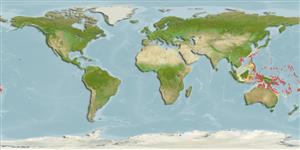Common names from other countries
Environment: milieu / climate zone / depth range / distribution range
Écologie
marin récifal; profondeur 5 - 25 m (Ref. 34024). Tropical
Western Central Pacific: Great Barrier Reef north of 16°S and in Papua New Guinea south of 5°S; westwards in Maluku, Indonesia; along the Louisiade Archipelago to the Solomon Islands including Santa Cruz Islands and Vanuatu.
Taille / Poids / Âge
Maturity: Lm ? range ? - ? cm
Max length : 10.3 cm SL mâle / non sexé; (Ref. 57884); 10.0 cm SL (female)
Rayons mous dorsaux (Total): 74-85; Rayons mous anaux: 60 - 69; Vertèbres: 43 - 45. The species is characterized by the following: vertebrae 11+32-34=43-45, dorsal fin rays 74-85 (mostly >77), anal fin rays 60-69, D/V 6 (rarely 7); large eyes (2.1-3.4% SL); outer pseudoclasper with broad hook-shaped extension, with rounded tip, slightly bent outwards; inner pseudoclasper short, joined to outer pseudoclasper anteriorly, supporter with anteriorly oriented small hook, and with a wide thin flap at posterior-distal margin; scale patch on cheek with 7-9 scale rows on upper cheek, many scales on operculum above opercular spin (7-16 scales in 2-4 rows), in very large specimens additional scale patch below opercular spine (4-12); head profile is moderately slender; otolith length sulcus length 1.9-2.0, sulcus slightly inclined (Ref. 57884).
Rare species, found on coral-sand bottom (Ref. 34024). Benthic (Ref. 75154). Cryptic and solitary (Ref 90102).
Life cycle and mating behavior
Maturité | Reproduction | Frai | Œufs | Fécondité | Larves
Schwarzhans, W., P.R. Møller and J.G. Nielsen, 2005. Review of the Dinematichthyini (Teleostei, Bythitidae) of the Indo-West-Pacific. Part I. Diancistrus and two new genera with 26 new species. The Beagle, Records of the Museum and Art Galleries of the Northern Territory 21:73-163. (Ref. 57884)
Statut dans la liste rouge de l'IUCN (Ref. 130435)
CITES (Ref. 128078)
Not Evaluated
Menace pour l'homme
Harmless
Utilisations par l'homme
Pêcheries: sans intérêt
Plus d'informations
PaysZones FAOÉcosystèmesOccurrencesIntroductionsStocksÉcologieRégime alimentaireÉléments du régime alimentaireConsommation alimentaireRation
RéférencesAquacultureProfil d'aquacultureSouchesGénétiqueElectrophoresesHéritabilitéPathologiesTraitementMass conversion
CollaborateursImagesStamps, Coins Misc.SonsCiguateraVitesseType de nageSurface branchialeOtolithesCerveauxVision
Outils
Articles particuliers
Télécharger en XML
Sources Internet
Estimates based on models
Preferred temperature (Ref.
115969): 26.1 - 29.3, mean 28.6 (based on 1516 cells).
Phylogenetic diversity index (Ref.
82804): PD
50 = 0.5000 [Uniqueness, from 0.5 = low to 2.0 = high].
Bayesian length-weight: a=0.00389 (0.00180 - 0.00842), b=3.12 (2.94 - 3.30), in cm Total Length, based on all LWR estimates for this body shape (Ref.
93245).
Niveau trophique (Ref.
69278): 3.4 ±0.5 se; based on size and trophs of closest relatives
Résilience (Ref.
120179): Faible, temps minimum de doublement de population : 4,5 à 14 années (Assuming Fec < 100).
Fishing Vulnerability (Ref.
59153): Low vulnerability (10 of 100).
